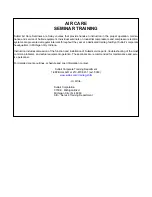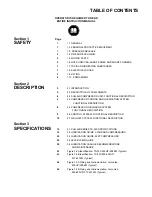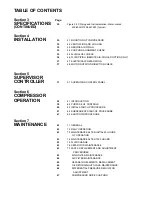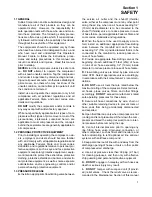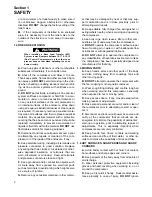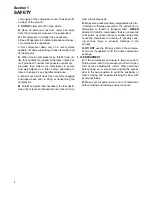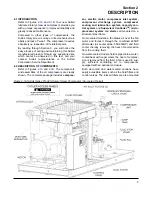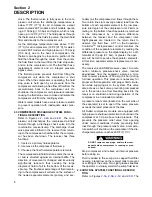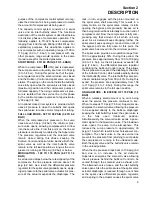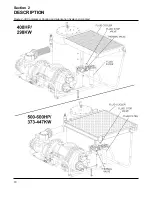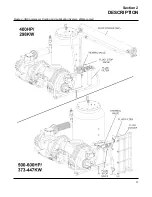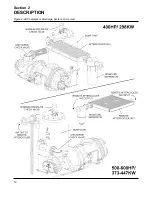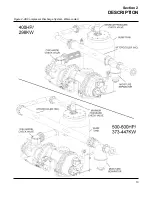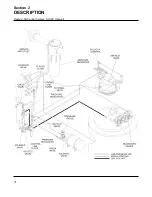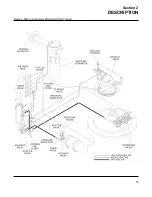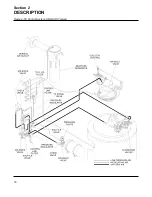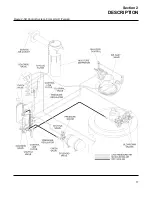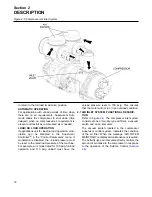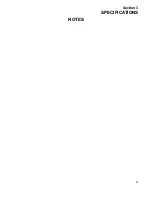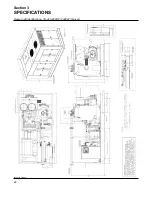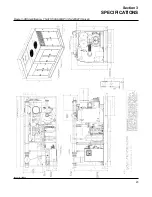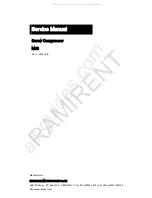
purpose of the compressor control system is to reg-
ulate the amount of air being compressed to match
the amount of compressed air being used.
The capacity control system consists of a spiral
valve and an inlet butterfly valve. The functional
description of the control system is described below
in 4 distinct phases of compressor operation. The
following applies to TS-32S Series compressors
ranging from 400 through 600hp (298-447kw). For
explanatory purposes, this description applies to
any compressor with an operating range of 100 to
110 psig (6.9 to 7.6 bar). A compressor with any
other pressure range would operate in the same
manner except for the stated pressures.
START MODE - 0 TO 50 PSIG (0 TO 3.4 BAR)
When the compressor
(ON) pad is depressed,
the sump pressure will quickly rise from 0 to 50 psig
(0 to 3.4 bar). During this period, both of the pres-
sure regulators and the solenoid valve are closed
and the Sullicon Control and spiral valve are inop-
erative. The spring on the control holds the butterfly
valve fully open while the spiral valve is fully closed
(maximum) position and the compressor pumps at
full rated capacity. The rising compressor air pres-
sure is isolated from the service line in this phase
by the minimum pressure valve set at approximate-
ly 50 psig (3.4 bar).
An optional closed inlet system is provided which
uses air pressure to close the butterfly and opens
the spiral valve to reduce motor torque for starting.
FULL LOAD MODE - 50 TO 100 PSIG (3.4 TO 6.9
BAR)
When the compressed air pressure in the sump
rises above 50 psig (3.4 bar), the minimum pres-
sure valve opens, allowing compressed air to flow
into the service line. From this point on, the line air
pressure is continually monitored by the Supervisor.
The pressure regulators and the solenoid valve
remain closed during this phase, keeping the
Sullicon Control and spiral valve inactive. Both the
spiral valve as well as the inlet butterfly valve
remain in the full load position as long as the com-
pressor is running at 100 psig (6.9 bar) or below.
MODULATION - 100 TO 110 PSIG (6.9 TO 7.6
BAR)
As air demand drops below the rated capacity of the
compressor, the line pressure will rise above 100
psig (6.9 bar). As a result, the differential pressure
regulator for the spiral valve gradually opens, apply-
ing air pressure to the spiral valve actuator. Air pres-
sure at the actuator expands the diaphragm. The
rack, in turn, engages with the pinion mounted on
the spiral valve shaft assembly. This results in a
rotary motion. As the spiral valve rotates, it starts
opening the bypass ports gradually. Excess air is
then being returned back internally to suction end of
compressor unit. Now the compressor is fully com-
pressing only that amount of air which is being
used. As air demand keeps dropping further, the
spiral valve keeps opening more and more until all
the bypass ports are fully open. At this point, the
spiral valve has moved into the minimum position.
The spiral valve provides a modulation range from
100 to approximately 50%. During this period, the
pressure rises approximately from 100 to 108 psig
(6.9 to 7.4 bar). As the air pressure exceeds 108
psig (7.4 bar), the differential pressure regulator
controlling the Sullicon Control opens. This allows
the air pressure to expand the diaphragm chamber
of the Sullicon Control, which starts partially closing
the inlet butterfly valve. The inlet butterfly valve pro-
vides modulation range from 50 to 40%. During this
period, the pressure rises approximately from 108
to 110 psig (7.4 to 7.6 bar). During this range, the
spiral valve remains in the full open position.
UNLOAD MODE - IN EXCESS OF 110 PSIG (7.6
BAR)
When a relatively small amount or no air is being
used, the service line pressure continues to rise.
When it exceeds 110 psig (7.6 bar), Supervisor de-
energizes the solenoid valve allowing line pressure
to be supplied directly to the Sullicon diaphragm
keeping the inlet butterfly closed; the spiral valve is
in the fully open (minimum) position.
Simultaneously, the solenoid valve sends a pneu-
matic signal to the blowdown valve. The blowdown
valve opens the sump to the atmosphere. This
reduces the sump pressure to approximately 30
psig (2.1 bar) which results in low horsepower con-
sumption. The check valve in the air service line
prevents line pressure from returning to sump while
the compressor is running in the unloaded mode.
Both the spiral valve and the butterfly valve remain
in the unload position.
When the line pressure drops back to 100 psig (6.9
bar) due to an increase in the air demand,
Supervisor energizes the solenoid valve allowing
the air pressure behind the Sullicon Control to be
vented through the solenoid valve exhaust port.
The blowdown valve closes, and the inlet butterfly
valve opens. Also the air pressure at the spiral valve
actuator diaphragm is reduced through a vent hole
at the spiral valve differential pressure regulator,
and a spring in the actuator causes the spiral valve
Section 2
DESCRIPTION
9
Summary of Contents for TS-32S
Page 16: ...Section 2 DESCRIPTION 10 Figure 2 3A Compressor Cooling and Lubrication System Air cooled...
Page 17: ...Section 2 DESCRIPTION 11 Figure 2 3B Compressor Cooling and Lubrication System Water cooled...
Page 18: ...Section 2 DESCRIPTION 12 Figure 2 4A Compressor Discharge System Air cooled...
Page 19: ...Section 2 DESCRIPTION 13 Figure 2 4B Compressor Discharge System Water cooled...
Page 20: ...Section 2 DESCRIPTION 14 Figure 2 5A Control System START Typical...
Page 21: ...Section 2 DESCRIPTION 15 Figure 2 5B Control System MODULATION Typical...
Page 22: ...Section 2 DESCRIPTION 16 Figure 2 5C Control System UNLOAD Typical...
Page 23: ...Section 2 DESCRIPTION 17 Figure 2 5D Control System FULL LOAD Typical...
Page 27: ...Section 3 SPECIFICATIONS 21 NOTES...
Page 40: ...34 NOTES...
Page 48: ...42 NOTES...
Page 60: ...54 NOTES...
Page 63: ...57 NOTES...
Page 72: ...Section 8 ILLUSTRATIONS AND PARTS LIST 66 8 5 AIR INLET SYSTEM 02250135 499R01...
Page 114: ...Section 8 ILLUSTRATIONS AND PARTS LIST 108 02250135 534R03 8 20 SUMP AND PARTS...
Page 116: ...Section 8 ILLUSTRATIONS AND PARTS LIST 110 02250135 534R03 8 20 SUMP AND PARTS...
Page 118: ...Section 8 ILLUSTRATIONS AND PARTS LIST 112 02250134 158R00 8 21 SULLICON CONTROL...
Page 120: ...Section 8 ILLUSTRATIONS AND PARTS LIST 114 8 22 COMPRESSOR SPIRIAL VALVE ACTUATOR...
Page 124: ...Section 8 ILLUSTRATIONS AND PARTS LIST 118 02250135 643R05 8 24 PNEUMATIC CONTROLS...
Page 126: ...Section 8 ILLUSTRATIONS AND PARTS LIST 120 02250135 643R05 8 24 PNEUMATIC CONTROLS...
Page 128: ...Section 8 ILLUSTRATIONS AND PARTS LIST 122 02250135 643R05 8 24 PNEUMATIC CONTROLS...
Page 134: ...Section 8 ILLUSTRATIONS AND PARTS LIST 128 8 27 CONTROL BOX WYE DELTA TYPICAL 02250122 516R08...
Page 140: ...Section 8 ILLUSTRATIONS AND PARTS LIST 134 02250133 674R04 8 30 ENCLOSURE AIR COOLED...
Page 142: ...Section 8 ILLUSTRATIONS AND PARTS LIST 136 02250133 674R04 8 30 ENCLOSURE AIR COOLED...
Page 144: ...Section 8 ILLUSTRATIONS AND PARTS LIST 138 02250133 675R04 8 31 ENCLOSURE WATER COOLED...
Page 146: ...Section 8 ILLUSTRATIONS AND PARTS LIST 140 02250133 675R04 8 31 ENCLOSURE WATER COOLED...
Page 148: ...Section 8 ILLUSTRATIONS AND PARTS LIST 142 8 32 DECALS...
Page 150: ...Section 8 ILLUSTRATIONS AND PARTS LIST 144 8 32 DECALS...
Page 152: ...Section 8 ILLUSTRATIONS AND PARTS LIST 146 8 32 DECALS...
Page 154: ...Section 8 ILLUSTRATIONS AND PARTS LIST 148 8 33 DECAL LOCATIONS...
Page 156: ...Section 8 ILLUSTRATIONS AND PARTS LIST 150 8 34 DECAL LOCATIONS AIR COOLED ENCLOSURE TYPICAL...
Page 158: ...Section 8 ILLUSTRATIONS AND PARTS LIST 152 8 35 DECAL LOCATIONS WATER COOLED ENCLOSURE TYPICAL...
Page 160: ...Section 8 ILLUSTRATIONS AND PARTS LIST 154 8 36 DECAL LOCATIONS CONTROL BOX...
Page 162: ...Section 8 ILLUSTRATIONS AND PARTS LIST 156 8 37 DECAL LOCATIONS AFTER COOLER...
Page 171: ...NOTES...


